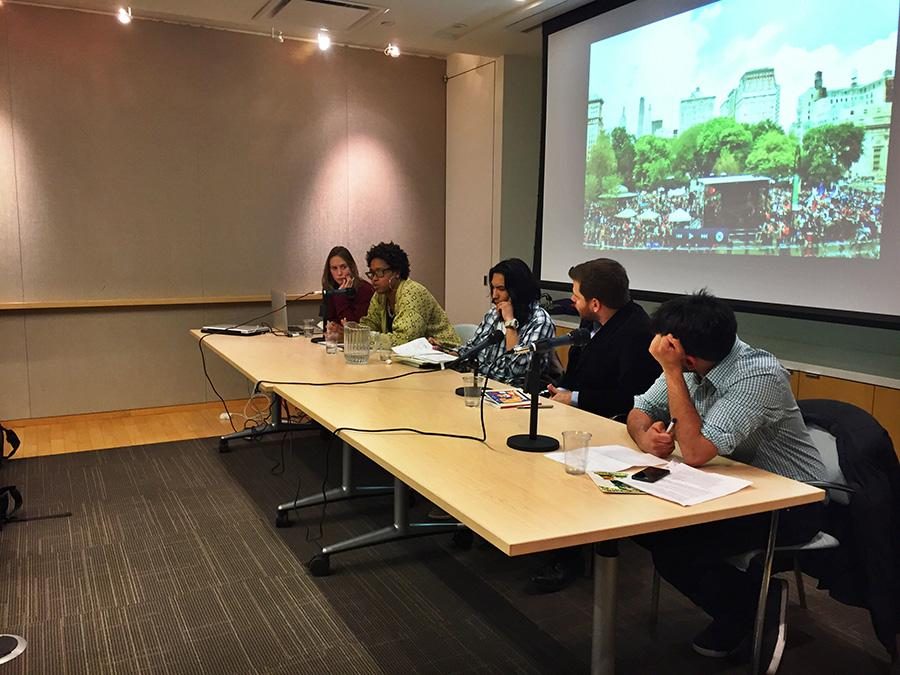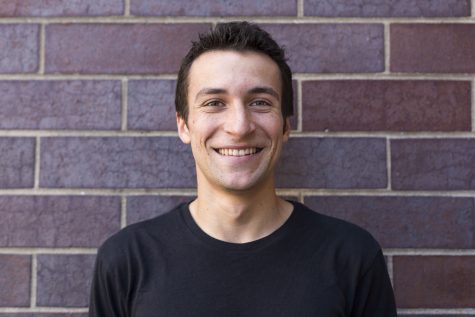Occupiers consider legacy of movement
Laura Gottesdiener, Michelle Crentsil, Diego Ibanez, Michael Gould-Wartofsky, Bhaskar Sunkara, from left, discuss Gould-Wartofsky’s new book.
February 18, 2015
Activists convened to discuss the successes and difficulties of the Occupy Wall Street movement on Tuesday at NYU’s Urban Democracy Lab. The event was hosted following the launch of author Michael Gould-Wartofsky’s new book “The Occupiers: The Making of the 99 Percent Movement.”
The panel featured Gould-Wartofsky, a doctoral candidate in sociology at NYU, as well as Laura Gottesdiener, Diego Ibanez and Michelle Crentsil, three activists of the Occupy Wall Street movement. Bhaskar Sunkara, editor and publisher for Jacobin magazine, moderated the panel. The discussion was largely centered around the history and future of the
Occupy movement.
Gould-Wartofsky’s book presents a front-line account of the Occupy Wall Street movement. He said while the “99 percent and 1 percent” slogan was a great way of translating the language into something everyone could understand, it also left out a lot, which is part of what motivated him to write
the book.
“I don’t think we have to be a movement that accepts our place on the margins of society,” Gould-Wartofsky said. “But we have to claim a place where the marginalized can speak and be heard.”
Gottesdiener, a worker in a community kitchen in Zuccotti Park, said she enjoyed the idea that everyone — even the most unlikely of candidates — was involved in crafting the movement.
“One of the cool things, and also one of the challenging things, about Occupy was everyone was shaping the politics of it all at the same time, regardless of any political knowledge walking into it,” Gottesdiener said.
Acknowledging that there were a lot of flaws with the Occupy movement, Gould-Wartofsky said lack of unity among the protesters held the movement back.
“I do think you need common aims, and you need a shared sense of a horizon and a next step,” Gould-Wartofsky said. “That’s also something that a lot people acknowledged that Occupy lacked at a certain point.”
Ibanez, a co-creator of the Occupy Wall Street Immigrant Justice Working Group, said the movement helped him connect with different struggles. He admitted that the movement could use work, but contested the commonly held belief that the goal of Occupy is to create immediate results.
“Our role is not to create a revolution now,” Ibanez said. “It’s essentially to create the conditions for the next generation to create the conditions — who knows how far that goes — to create a revolution.”
John Chang, a 24-year-old union worker, said he was not involved in the Occupy movement but he was drawn to the event by how much his work connected to it.
“What I found potentially appealing about this panel was the overlap between the work that Occupy activists did and are continuing to do and the work that I do,” Chang said.
Gould-Wartofsky said he felt consensus was possible, and that the issue was with how many people with fundamentally different interests were involved. Despite this, he said he still feels that the movement has momentum.
“We’re still in a situation where the conditions that led a generation to Occupy are still very much with us,” Gould-Wartofsky said. “And we have to ask, ‘What is the next step?’ and ‘What is the horizon?’”



























































































































































